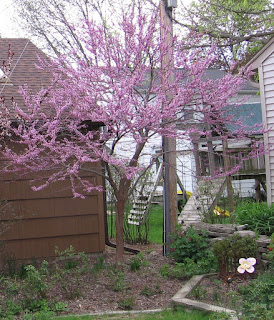I
thought I would give the seeds a try – why not! I soaked the pods in a dish of
water for several days. Eventually, the pod sort of broke apart and there were
several individual seeds, about the size of a bean seed, inside. I planted
several in a few small containers of potting mix outside on my patio. Surprise!
They sprouted! But, I still couldn’t tell what the plant was. I gave a few of
the seedlings to my mom-in-law, and I planted 4 of them in my yard – 2 near the
Plum tree stump, and 2 in the back bed.
All
the seedlings survived, and have grown bigger. I now know they are Castor Bean
plants. Look, they already have seed pods!
The
ones in the back area are almost 4 feet tall at this point. I’m hoping for more
height as summer goes on.
At
a nursery in my area, there is an enormous Wisteria vine covering an 8 sided
gazebo. I was admiring it one day when I saw some bean-like seeds on the ground
(lots of them). I picked up a handful and took them home. Again I soaked these
seeds in a dish of water for several days. I planted a few in small containers,
and 2 sprouted! I don’t know what to do with these yet since I really don’t
have a spot for Wisteria.
Last
year, in my annual flower pots in the front of the house, I had some Balsam.
The flowers eventually went to seed, and dropped their seeds all over the front
area where they got washed into the nearby beds. I didn’t think much about it.
This spring, I got a flurry of Balsam seedlings right near the front stoop. Enough
that I was able to spread the seedlings throughout the front beds and many are
blooming!




































